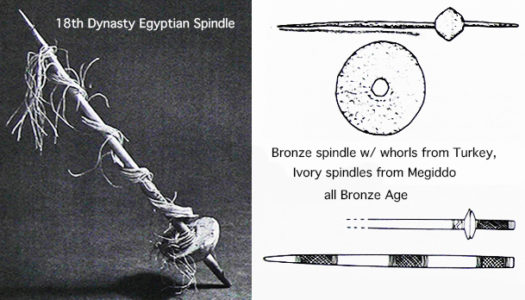

I knew absolutely nothing about the roots of the phrase “born to the purple” when I began writing Purple. Neither had I ever heard of the Murex trunculus, a predatory sea snail found along many Mediterranean coasts, from which the royal purple dye was extracted. Even more humbling was my discovery that I understood nothing whatever about how cloth is spun and woven–now, or in the 1st Century CE. Oh, I knew the words and how to use them in sentences: warp and weft, loom and shuttle, spindle and bobbin . . . but I soon realized that I didn’t have a clue what any of those objects actually did in the process of transforming raw material–wool in particular–into cloth.
Textile manufacture was one of a very few areas where a women might succeed in business in New Testament times. The reference in Acts 16:14, to “Lydia, a dealer in purple fabric,” was one obvious instance. And if I did decide to write about a woman skilled in weaving, I needed to understand what was involved in that skill. So I checked out every book I could find in local public libraries about weaving wool, from raising the sheep to selling the finished textiles–and I hardly understood a word. Every book, no matter how simple, either assumed I already knew what weaving terms meant, or explained the meanings so superficially that they might as well have been speaking a foreign language–which is what the specialist terms of any discipline are to outsiders.
I tried websites, and YouTube, and eventually went to the library at Bard College where I finally discovered THE reigning expert in ancient textile studies–who understood the necessity of defining every single term before starting to use it, no matter how obvious it might seem to her. Her name is Elizabeth Wayland Barber, and she is the author of a highly entertaining and groundbreaking scholarly survey called Prehistoric Textiles (1991), and a more popular adaptation, entitled Women’s Work: The first 20,000 years (1994). I could never have written the book without her!

So, as a gesture of appreciation to her for her blessed clarity and thoroughness, I will try to explain the basics of early 1st C wool manufacture in Israel. I speak of wool particularly, because Murex dye only stains animal fiber successfully, and only wool absorbs the color thoroughly enough to create the deep blackish red-violet hue that royalty prized.
Sheep were raised in hilly and mountainous areas throughout the Ancient Near East. In most instances they were sheared and the wool cleaned and processed wherever the sheep were raised. Often a cottage industry grew up among local women for the spinning of the thread, so that urban weavers never worked with the fleece at all. But I’ve already begun to use words without defining them, so I’ll pause and look more closely at this first stage.
Preparing the fleece
By the 1st C, sheep had been selectively bred for thick, long fleece of various colors. Each spring the sheep were sheared with large iron shears. In the eastern Mediterranean, the first task after shearing was removing the larger problem areas from the fleece: dung tags, short, poor quality wool, matted wool, hardened grease. The fleece was then laid out on a rack and beaten with flexible rods to remove dust and seeds.
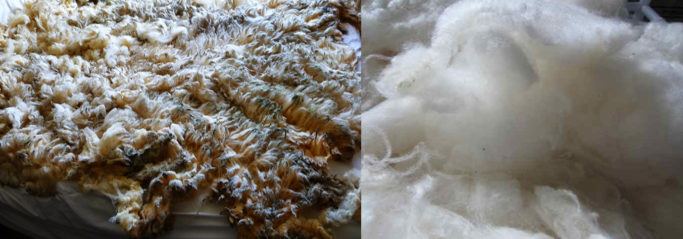
Then the fleece was washed with some sort of solvent, in order to remove the grease–otherwise dye would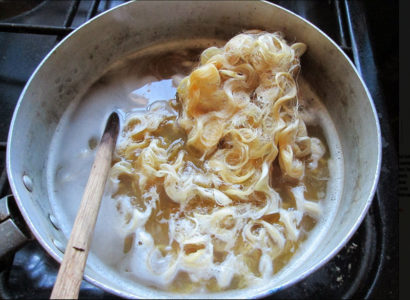 not take. Roughly twenty gallons of hot liquid was needed to wash two whole fleeces. In Israel, typically 3 parts hot water and 1 part urine were combined for the wash. The wool pelts were carefully teased apart and gently submerged in the washing vat, where they remained overnight. The washers took extreme care not to stir the wool in the bath, especially when the water was still hot, since that could cause it to “felt”, or stick together in a mat that couldn’t be spun or woven, although lesser quality wool was often “felted” intentionally. After soaking, the wool was carefully and thoroughly rinsed. In Israel the washed wool was either spread over bushes or put into light bags, swung around in circles, and then spread out to dry.
not take. Roughly twenty gallons of hot liquid was needed to wash two whole fleeces. In Israel, typically 3 parts hot water and 1 part urine were combined for the wash. The wool pelts were carefully teased apart and gently submerged in the washing vat, where they remained overnight. The washers took extreme care not to stir the wool in the bath, especially when the water was still hot, since that could cause it to “felt”, or stick together in a mat that couldn’t be spun or woven, although lesser quality wool was often “felted” intentionally. After soaking, the wool was carefully and thoroughly rinsed. In Israel the washed wool was either spread over bushes or put into light bags, swung around in circles, and then spread out to dry.

Once the fleece dried, it was gently pulled apart into separate strands, and shaken to remove any remaining seeds. By the 1st C, the different lengths of wool fibers weren’t separated unless the women doing the spinning intended to make the hard strong thread called worsted, which required long fibers laid out straight alongside each other. “Carding” was the most common method of preparing fleece for spinning by the 1st C. It involved lightly brushing or fluffing the wool fibers between two “cards” with protruding teeth–a bit like teasing hair. It resulted in a mass of fluffy fiber, evenly combed and separated, that could be pulled out in a steady thin stream for spinning.
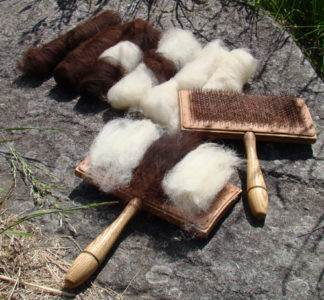
Spinning
Ancient ingenuity gradually produced simple tools to make the intensely frustrating process of early spinning relatively easy. Barber put it something like this. Hand-spinning involved 3 processes–thinning and lengthening, twisting, and winding the thread onto a holder. But to do this, a woman really needed 4 hands:
- 1 hand to hold the prepared fluff of wool fibers
- 1 hand to pull thinned fibers out of the fluff and attach them to the emerging thread
- 1 hand to keep twisting the thread
- and 1 hand to hold finished thread, lest it ball up like angry rubber band
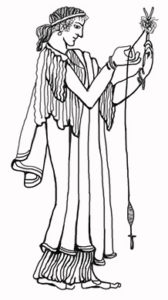
The distaff (“fuzz-stick”) was developed to hold a large mass of prepared fuzzy fleece; often it was no more than a forked stick held by the weaver. She pulled a steady stream of fuzz off the distaff, attaching it to the emerging thread. The “spindle” solved two problems at one time: how to twist the emerging length of fluff, and how to anchor the spun thread so that it wouldn’t recoil on itself. A spindle is basically a smooth stick of wood about a foot long, with a hook or groove for attaching thread, and a “whorl,” a roughly cylindrical object with a centered hole, attached to the shaft of the spindle, to reduce wobble. The thread is attached to the spindle, the spindle is set spinning, dropped, and spins the thread on its own like a top as the spinner uses her 2nd hand to pull and secure the fibers. When the spindle slows and stops, the spinner winds the accumulated thread around the spindle and sets it spinning again. Skilled spinners hardly pause at all between one spin and the next, and maneuver the spindle to wind the finished thread almost without guidance.
The last step in spinning is “plying.” When the twisted thread is removed from the spindle if it is not “plied,” it will simply unravel. So 2 threads are twisted together in the opposite direction to their original spin (plied), resulting in a length of thread that is not only twice as thick, but doesn’t unravel, either.
Weaving
In Barber’s words, “Weaving involves two sets of strings: a fixed set, the warp, and a second set, the weft, interlaced into the warp. But the flexibility of string makes interlacing terribly difficult without a way to hold some of the strings in place—a frame to provide tension. That frame is called a loom. Discovering how to provide tension made true weaving possible” (Prehistoric Textiles, p. 80).
From about the year 2000 BCE until the time of Christ, women in Palestine did most of their weaving on warp-weighted looms–vertical looms that leaned against walls. Women stood to weave and the finished cloth accumulated at the top. Warp-weighted looms were called by this name because the warp threads–the strong vertical threads through which the woof or weft threads were woven, were held in place by weights attached at the bottom. A famous Greek urn from around 600 BCE shows one such loom (below). Several threads secured on the top beam are weighed down together in straight lines by clay, stone or other types of weights at the bottom. The woman on the left is beating, or pushing, the most recent weft threads up tightly into the finished cloth rolled onto the top beam. The woman on the right is weaving the horizontal weft thread between the vertical warp threads.
The size of the loom depended partly on the type of fiber being woven. Estimates based on loom weights and surviving fragments of cloth suggest that the width of woven wool varied between 33-78 cm. Light fibers like linen and hemp were often wider.
Here are some basic weaving terms:
Loom = frame holding thread for weaving
Loom weights = stones, etc., attached to bottom of warp threads/groups of threads
Warp = the vertical weighted threads
Weft (old past tense of weave) = horizontal threads added in between warp threads
Plain weave = one thread of warp over/under one of weft, etc. This was the simplest weave, still seen today in sheets and pillowcases. Pattern was added by taking the weft over and under different numbers of warp threads
Starting border = a narrow woven band attached to upper beam to keep warp threads separate and spaced evenly
Heddle rod = movable rod that leans against front of loom, either resting against loom itself, or lifted up and away and resting on supports.
Heddles = small loops w/strings attached to the heddle rod, through which alternating warp threads pass (1 string/group of strings thru each heddle). Heddle loops are each tied to the heddle rod. When the heddle rod is lifted up onto its supports, it creates a gap (shed) between warp threads attached to it (and now raised) and the warp threads below not attached to heddles.
Shed rod = moveable rod at base of loom above loom weights over which the alternate warp threads not tied to heddles are hung. When heddle rod is lowered from its supports, the shed rod holds its threads above the others (the lower threads above the heddle threads), creating a second shed through which to pass a weft thread.
Shed = the gap between alternating layers of warp threads through which weft is pulled. The whole line of weft is passed through this passageway/gap with a shuttle
A drawing from Barber’s Prehistoric Textiles (below) may help these terms make sense. This drawing shows a simple kind of warp-weighted loom probably found in Palestinian homes in the early 1st C CE (I used her drawing as the model for the one in Purple):
So here’s the process, vastly simplified:
- Tie the warp threads to top of loom, draping all warp threads over frame
- Attach starting border to upper beam, woven of cord, to keep warp cords evenly spaced and not crowded
- Thread alternate warp threads into consecutive heddle loops attached to heddle rod toward top of loom, letting ends hang down toward floor
- The lower (unattached to heddles) warp threads remain over shed rod at bottom, so that they hang straight from woven fabric at top to rod at base
- Attach weights to all warp threads/groups by small cords
- Lift heddle rod up on to supports to create shed between lower warp and heddled warp threads
- Send weft through the shed
- Beat up toward top tightly
- Lower heddle rod from supports to loom frame; the heddled warp threads will hang below loom frame from heddles, toward floor
- Alternate warp threads draped over shed rod will now be higher, creating a shed between lower and upper warp threads
- Send weft through 2nd shed, beat up, and repeat.
- Finished cloth rolled up on top beam

Then sometime in the mid-to-late 1st C CE all this changed with the introduction of the upright two-beam loom, developed somewhere in the Levant and/or Syria and spread by the Romans throughout the rest of the empire. The weights were replaced by a second horizontal beam at the bottom, and the weaving went from top to bottom, which meant that the weaver could sit while weaving.
The main problem scholars have had in understanding early weaving techniques has been that neither wooden looms nor textiles often survive over time, although the clay, stone, and bone tools often do. The sudden disappearance of loom weights from archaeological sites dating to the beginning of the 2nd century CE was the most obvious indication of the change in weaving technology.

One last interesting observation on cloth made in the first century is the time involved. A simple garment of a plain weave used approximately 1.5 x 5 meters of cloth. The spinning of the thread alone took approximately 120 hours. Setting up the loom with the border and warp threads took about 50 hours, with another 50-60 hours for the weaving itself. By the time you added in the sewing and finishing, the total time invested in one simple garment would be over 250 hours!
.

